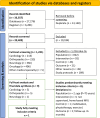Multicomponent rehabilitation to improve independence and functioning in elderly patients with common age-associated diseases: a scoping review
- PMID: 39842924
- PMCID: PMC11883612
- DOI: 10.1136/bmjopen-2023-083733
Multicomponent rehabilitation to improve independence and functioning in elderly patients with common age-associated diseases: a scoping review
Abstract
Objective: Multicomponent rehabilitation (MR) could restore functioning in elderly patients after hospitalisation, even beyond geriatrics, but specific evidence seems lacking. This review mapped the evidence on MR in elderly patients following hospitalisation for age-related conditions regarding functioning-related outcomes.
Design: Scoping review.
Data sources: PubMed, Cochrane Library, International Clinical Trials Registry Platform and ClinicalTrials.gov (searched through 24 June 2024).
Eligibility criteria: We included randomised controlled trials (RCT) and controlled cohort studies (CCS) comparing centre-based MR with usual care (medical care excluding exercise training) in patients ≥75 years, hospitalised for age-related cardiac, neurological, oncological and orthopaedic diseases. MR was defined as exercise training and at least one additional component (eg, nutritional counselling), starting within 3 months after hospital discharge. RCTs and CCS were included from inception, without language restriction. Care dependency, physical function, health-related quality of life (HRQL) and activities of daily living (ADL) after ≥6 months follow-up were the outcomes of interest.
Data extraction and synthesis: Four reviewers independently screened titles, abstracts and full texts for inclusion and extracted data. MR components and the typology of outcome assessments used were mapped at the final data synthesis level.
Results: Out of 20 409 records, nine studies were investigated in the final data synthesis. Throughout these studies, disease education was the most frequent MR component besides exercise training, while physical function, HRQL and ADL were commonly assessed outcomes. One RCT (cardiac rehabilitation, 80±0.3 years, MR/usual care n=24/23) fully met the inclusion criteria and reported improvements in physical function (2 months) and in HRQL (2, 8, 14 months post intervention) in MR patients.
Conclusions: Evidence on MR regarding functioning-related outcomes in ≥75-year-old patients is sparse beyond geriatrics. There is an essential need for studies investigating the capabilities of MR in this growing and under-represented patient population.
Trial registration number: OSF (https://doi.org/10.17605/OSF.IO/GFK5C).
Keywords: Aged; Chronic Disease; Patient Participation; Patient Reported Outcome Measures; Patient-Centred Care; REHABILITATION MEDICINE.
© Author(s) (or their employer(s)) 2025. Re-use permitted under CC BY-NC. No commercial re-use. See rights and permissions. Published by BMJ Group.
Conflict of interest statement
Competing interests: None declared.
Figures


Similar articles
-
Effect of multicomponent rehabilitation on independence and functioning in elderly patients with common age-associated diseases: protocol for a scoping review (REHOLD).BMJ Open. 2023 May 18;13(5):e068722. doi: 10.1136/bmjopen-2022-068722. BMJ Open. 2023. PMID: 37202142 Free PMC article.
-
Folic acid supplementation and malaria susceptibility and severity among people taking antifolate antimalarial drugs in endemic areas.Cochrane Database Syst Rev. 2022 Feb 1;2(2022):CD014217. doi: 10.1002/14651858.CD014217. Cochrane Database Syst Rev. 2022. PMID: 36321557 Free PMC article.
-
Exercise-based cardiac rehabilitation for adults with heart failure.Cochrane Database Syst Rev. 2019 Jan 29;1(1):CD003331. doi: 10.1002/14651858.CD003331.pub5. Cochrane Database Syst Rev. 2019. Update in: Cochrane Database Syst Rev. 2024 Mar 7;3:CD003331. doi: 10.1002/14651858.CD003331.pub6. PMID: 30695817 Free PMC article. Updated.
-
Telerehabilitation services for stroke.Cochrane Database Syst Rev. 2020 Jan 31;1(1):CD010255. doi: 10.1002/14651858.CD010255.pub3. Cochrane Database Syst Rev. 2020. PMID: 32002991 Free PMC article.
-
Exercise-based cardiac rehabilitation for chronic heart failure: the EXTRAMATCH II individual participant data meta-analysis.Health Technol Assess. 2019 May;23(25):1-98. doi: 10.3310/hta23250. Health Technol Assess. 2019. PMID: 31140973 Free PMC article. Review.
References
-
- World Health Organization World report on ageing and health. 2015
-
- National Institute for Health and Care Research Multiple long-term conditions (multimorbidity): making sense of the evidence. 2021
Publication types
MeSH terms
LinkOut - more resources
Full Text Sources
Miscellaneous
